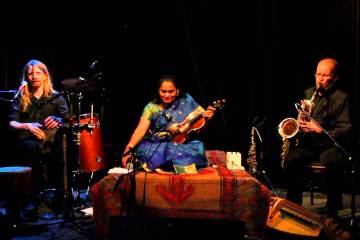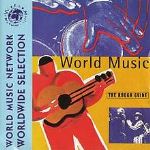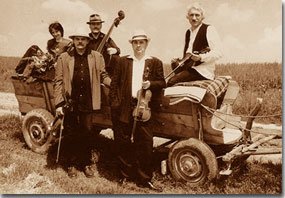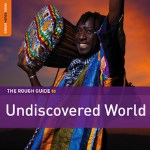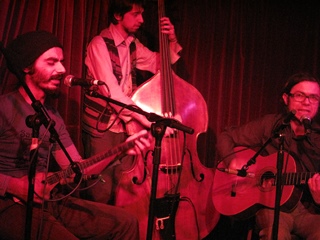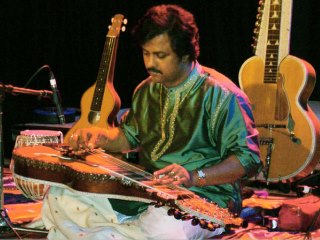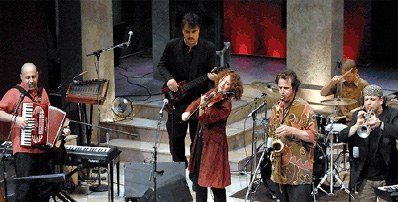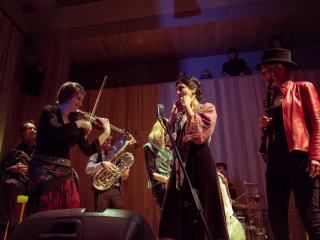FolkWorld #66 07/2018
World Music
A quarter of a century since the ground-breaking Rough Guide To World Music was first
released, an anniversary edition celebrates the beauty and diversity of musical cultures both past and present.
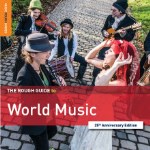
Ft. Rafiki Jazz,
Kries,
Monoswezi,
Shanren,
Debashish Bhattacharya,
Nordic Raga,
Alba Griot,
Kristi Stassinopoulou & Stathis Kalyviotis,
Ramzi Aburedwan,
Rocqawali,
Guillaume Barraud Quartet,
She'Koyokh,
Etran Finatawa,
Krar Collective,
Söndörgő.
Various Artists "The Rough Guide to World Music - 25th Anniversary Edition",
World Music Network, 2018
World music (also called global music or international music) is a musical category encompassing many different styles of music from around the globe, which includes many genres including some forms of Western music represented by folk music, as well as selected forms of ethnic music, indigenous music, neotraditional music, and music where more than one cultural tradition, such as ethnic music and Western popular music, intermingle.
World music's inclusive nature and elasticity as a musical category may pose for some obstacles to a universal definition, but its ethic of interest in the culturally exotic is encapsulated in fRoots magazine's description of the genre as "local music from out there".
The term was popularized in the 1980s as a marketing category for non-Western traditional music. Globalization has facilitated the expansion of world music's audiences and scope. It has grown to include hybrid subgenres such as world fusion, global fusion, ethnic fusion, and worldbeat.
Terminology
The Rough Guide to World Music is a world music compilation album originally released in the United Kingdom in 1994. The first of the World Music Network Rough Guides World Music series, it was co-released with an eponymous reference book.
The album features artists hailing from Africa, the Americas, Asia, and Europe. Artwork was designed by Impetus, and the compilation was produced by Phil Stanton, co-founder of the World Music Network.
Ft. Joe Arroyo,
Africando,
Oumou Sangare,
Zaiko Langa Langa,
Étoile de Dakar,
Cecile Kayirebwa,
Tarika Sammy,
Henry Kaiser & David Lindley,
Ali Hassan Kuban,
Sainkho Namtchylak,
Guo Yue & Joji Hirota,
Muzsikás,
Oyster Band,
Buckwheat Zydeco,
Talitha MacKenzie.
Various Artists "The Rough Guide to World Music",
World Music Network, 1994
The term has been credited to ethnomusicologist Robert E. Brown, who coined it in the early 1960s at Wesleyan University in Connecticut, where he developed undergraduate through the doctoral programs in the discipline. To enhance the process of learning, he invited more than a dozen visiting performers from Africa and Asia and began a world music concert series. The term became current in the 1980s as a marketing/classificatory device in the media and the music industry. There are several conflicting definitions for world music. One is that it consists of "all the music in the world", though such a broad definition renders the term virtually meaningless.
The term also is taken as a classification of music that combines Western popular music styles with one of many genres of non-Western music that are also described as folk music or ethnic music. However, world music is not exclusively traditional folk music. It may include cutting edge pop music styles as well. Succinctly, it can be described as "local music from out there", or "someone else's local music". It is a very nebulous term with an increasing number of genres that fall under the umbrella of world music to capture musical trends of combined ethnic style and texture, including Western elements (examples noted in this section).
World music may incorporate distinctive non-Western scales, modes and/or musical inflections, and often features distinctive traditional ethnic instruments, such as the kora (West African harp), the steel drum, the sitar or the didgeridoo.
Music from around the world exerts wide cross-cultural influence as styles naturally influence one another, and in recent years world music has also been marketed as a successful genre in itself. Academic study of world music, as well as the musical genres and individual artists associated with it appear in such disciplines as anthropology, folkloristics, performance studies and ethnomusicology.
Evolving terminology
In the age of digital music production the increased availability of high-quality, ethnic music samples, sound bites and loops from every known region are commonly used in commercial music production, which has exposed a vast spectrum of indigenous music texture to developing, independent artists. These influences proliferate quickly in a web-based music industry that is now percolating as a much larger, predominantly self-promoted menu, via an increasing number of indie-artist-friendly, streaming Internet options, such as Last.fm, Rhapsody, Live365, Jango Artist Airplay and ReverbNation.
An amalgamation of roots music in the global, contemporary listening palette has become apparent, which weakens the role major entertainment labels can play in the cultural perception of genre boundaries. As a result, definitions of the genre have become particularly varied, and determined by particularly wide-ranging and varied opinions.

Ft. Big Mimma,
Gabriella Ghermandi,
Chłopcy Kontra Basia,
Mostly Kosher,
Naba TT,
Anansy Cissé,
Solo & Indre,
Salt Petal,
Migala,
Oratnitza,
Sutari,
Simo Lagnawi,
Giuliano Modarelli & Kamaljeet Ahluwalia.
Various Artists "The Rough Guide To The Best World Music You've Never Heard",
World Music Network, 2016
This excellently eccentric Rough Guide is a whistle-stop tour of wild world music. The majority of music here is previously un-released, so you won’t hear this anywhere else, and it’s not worth missing. Enjoy everything from a trio of Romanian harmonica enthusiasts to a Zimbabwean-Brazilian jazz project, and more.
All the tracks featured here were entered into World Music Network’s innovative ‘Battle of the Bands’ competition. Via our online forum artists from all over the globe can visit our website, upload a track and drive support via social media platforms.
Ft. Saratuspersen,
Shanren,
Krar Collective,
Chłopcy Kontra Basia,
Julaba Kunda - Juldeh Camara & Griselda Sanderson,
Jadid Ensemble,
Zmei Trei,
Mosaic,
Monoswezi,
Matsubara,
Pax Nindi,
Trio Tekke,
Suaramantra,
Amadou Diagne,
Choir Invisible - The Desmond & Leah Tutu Peace Choir.
Various Artists "The Rough Guide To Undiscovered World",
World Music Network, 2012
Similar terminology between distinctly different sub-categories under primary music genres, such as world, rock and pop can be as ambiguous and confusing to industry moguls as it is to consumers. This is especially true in the context of world music, where branches of ethnically influenced pop trends are as genre-defined by consumer perception as they are by the music industry forums that govern the basis for categorical distinction. Academic scholars tend to agree that, in today's world of consumer music reviews and blogging, global music culture's public perception is what ultimately distils a prevailing basis for definition from genre ambiguity, regardless of how clearly a category has been outlined by corporate marketing forums and music journalism. The world music genre's gradual migration from a clear spectrum of roots music traditions to an extended list of hybrid subgenres is a good example of the motion genre boundaries can exhibit in a globalizing pop culture.
The classic, original definition of world music was in part created to instill a perceived authenticity and distinction between indigenous music traditions and those that eventually become diluted by pop culture, and the modern debate over how possible it is to maintain that perception in the richly diverse genre of world music is ongoing.
In a report on the 2014 globalFEST National Public Radio's Anastasia Tsioulcas said "Even within the "world music" community, nobody likes the term "world music." It smacks of all kinds of loaded issues, from cultural colonialism to questions about what's "authentic" and what isn't (and who might get to police such inquiries), and forces an incredible array of styles that don't have anything in common under the label of "exotic Other." What's more: I believe that in many people's imaginations, "world music" means a kind of fairly awful, gloppy, hippy-ish, worldbeat fusion. It's a problematic, horrible term that satisfies absolutely no one."
Forms
Examples of popular forms of world music include the various forms of non-European classical music (e.g. Japanese koto and Chinese guzheng music, Indian raga music, Tibetan chants), Eastern European folk music (e.g. the village music of the Balkans, The Mystery Of The Bulgarian Voices), Nordic folk music and the many forms of folk and tribal music of the Middle East, Africa, Asia, Oceania, Central and South America, Latin music, and Indonesian music.
The Breton musician Alan Stivell pioneered the connection between traditional folk music, modern rock music and world music with his 1972 album Renaissance of the Celtic Harp. At this time, Stivell's contemporary, Welsh singer-songwriter Meic Stevens popularised Welsh folk music. Neo-traditional Welsh language music featuring a fusion of modern instruments and traditional instruments such as the Pibgorn and the Welsh harp has been further developed by artists such as Bob Delyn a'r Ebillion. Lebanese musical pioneer Lydia Canaan fused Middle-Eastern quarter notes and microtones with anglophone folk, and is listed in the catalog of the Rock and Roll Hall of Fame and Museum's Library and Archives as the first rock star of the Middle East.
More recently, other Welsh-language bands such as Calan and 9 Bach have achieved international acclaim. Experimental psychedelic rock group Super Furry Animals's Welsh-language album Mwng was released in May 2000 and re-released in May 2015, captures the spirit of World music as 'trying to hang on to something that's under serious threat from advanced capitalism'.
The broad category of world music includes isolated forms of ethnic music from diverse geographical regions. These dissimilar strains of ethnic music are commonly categorized together by virtue of their indigenous roots. Over the 20th century, the invention of sound recording, low-cost international air travel and common access to global communication among artists and the general public has given rise to a related phenomenon called "crossover" music. Musicians from diverse cultures and locations could readily access recorded music from around the world, see and hear visiting musicians from other cultures and visit other countries to play their own music, creating a melting pot of stylistic influences. While communication technology allows greater access to obscure forms of music, the pressures of commercialization also present the risk of increasing musical homogeneity, the blurring of regional identities, and the gradual extinction of traditional local music-making practices.
Hybrid examples
Since the music industry established this term, the fuller scope of what an average music consumer defines as "world" music in today's market has grown to include various blends of ethnic music tradition, style and interpretation, and derivative world music genres have been coined to represent these hybrids, such as World fusion, Global fusion, Ethnic fusion or Worldbeat. Good examples of hybrid, world fusion are the Irish / West African meld of Afro Celt Sound System, the pan-cultural sound of Aomusic and the jazz / Finnish folk music of Värttinä, each of which bear tinges of contemporary, Western influence—an increasingly noticeable element in the expansion genres of world music. World fusion / Worldbeat / Ethnic fusion / Global fusion can also blend specific indigenous sounds with more blatant elements of Western pop. Good examples are Paul Simon's album Graceland, on which South African Mbaqanga music is heard, Peter Gabriel's work with Pakistani Sufi singer, Nusrat Fateh Ali Khan, the Deep Forest project, in which vocal loops from West Africa are blended with Western, contemporary rhythmic textures and harmony structure, and the work of Mango, who combined pop and rock music with world elements.
More recent bands who exhibit experimentation with World music Hybrid Forms include Vampire Weekend, The Very Best, Island Cassettes & Yeasayer, many of which cite inspiration from the work of Paul Simon.
Depending on style and context, world music can sometimes share the new-age music genre, which is a category that often includes Ambient music and textural expressions from indigenous roots sources. Good examples are Tibetan bowls, Tuvan throat singing, Gregorian chant or Native American flute music. World music blended with new-age music is a sound, loosely classified as the hybrid genre, ethnic fusion. Examples of ethnic fusion are Nicholas Gunn's "Face-to-Face" from Beyond Grand Canyon, featuring authentic Native American flute combined with synthesizers, and "Four Worlds" from The Music of the Grand Canyon, featuring spoken word from Razor Saltboy of the Navajo Indian Nation.
World fusion

Ft. Ska Cubano,
LA-33,
Amsterdam Klezmer Band,
Saba,
Ayhan Sicimoglu,
Roge,
Chris While And Julie Matthews,
Country Gentlemen,
David Lowe’s Dreamcatcher,
Los Fulanos Feat. Peret,
Mabulu,
Michael Mcgoldrick,
Hanggai,
Marcelinho Da Lua,
Jose Conde Y Ola Fresca,
Dean Martin,
Daniel Melingo,
Four Of A Kind,
João Sabiá,
Macolla,
Mokhtar Al Saïd & El Ferka El Masaya,
Diego Carrasco,
Wayne Gorbea's Salsa Picante,
Spam Allstars,
Carlitos Almonte Y Su Acordeon Cinco Estrellas,
Martirio,
Sami Ali,
Cuerdas Pop-temporaneas.
Various Artists "The Rough Guide To World Music For Children",
World Music Network, 2010
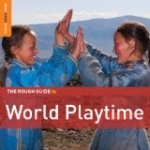
Ft. Maria De Barros,
Bela Lakatos & The Gypsy Youth Project,
Ukulele Club De Paris,
Lura,
Mariza,
Hijas Del Sol,
Mory Kante,
Peru Negro,
Chico César,
Takashi Hirayasu And Bob Brozman,
Lorin Sklamberg,
EA! Feat. Pilar 'La Monica' & J. J. Madrera,
Akim El Sikameya,
Wafir,
Kiran Ahluwalia,
Sambasunda Quintet,
Aurelio Martinez, by Mory Kante.
Various Artists "The Rough Guide To World Playtime",
World Music Network, 2011
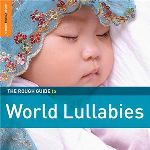
Ft. Omara Portuondo,
Kalei Napalapalai & Terii Tumahai,
Ali Farka Touré & Toumani Diabate,
Michel “Beausoleil” Doucet,
Axial,
Ginou Oriol,
Anghjula Potentini,
Chava Alberstein,
Hasmik Harutyunyan & The Shoghaken Ensemble,
Lucilla Galeazzi,
Vakoka,
Toto La Mamposina,
Netsayi,
Teresa Doyle,
Talitha MacKenzie, The Black Umfolosi.
Various Artists "The Rough Guide To World Lullabies",
World Music Network, 2011
The subgenre world fusion is often mistakenly assumed to refer exclusively to a blending of Western jazz fusion elements with world music. Although such a hybrid expression falls easily into the world fusion category, the suffix "fusion" in the term world fusion should not be assumed to mean only jazz fusion. Western jazz combined with strong elements of world music is more accurately termed world fusion jazz, ethnic jazz or non-Western jazz. World fusion and global fusion are nearly synonymous with the genre term worldbeat, and though these are considered subgenres of popular music, they may also imply universal expressions of the more general term, world music. Throughout the 1970s and 80s, fusion in the jazz music genre implied a blending of jazz and rock music, which is where the misleading assumption is rooted.
Popular non-Western genres
Although it primarily describes traditional music, the world music category also includes popular music from non-Western urban communities (e.g. South African "township" music) and non-European music forms that have been influenced by other so-called third-world musics (e.g. Afro-Cuban music), although Western-style popular song sourced from non-English-speaking countries in Europe (e.g. French pop music) would not generally be considered world music.
Paris is one of the great European capitals for world music. For many years, the city has attracted numerous musicians from former colonies in West and North Africa. This scene is aided by the fact that there are many concerts and institutions that help to promote the music.
Algerian and Moroccan music have an important presence in the French capital. Hundreds of thousands of Algerian and Moroccan immigrants have settled in Paris, bringing the sounds of Amazigh (Berber), raï, and Gnawa music. Algerian raï also found a large French audience.
The West African community is also very large, integrated by people from Senegal, Mali, Ivory Coast, and Guinea. They have introduced manding jeli music, mbalax and other styles.
After 1987: Women and beyond
One origin of the term was the initiation of World Music Day (Fête de la Musique) in 1982 in France. World Music Day has been celebrated on 21 June every year since then. On 29 June 1987 a meeting of interested parties gathered to capitalize on the marketing of this genre. Arguably popular interest was sparked with the release in 1986 of Paul Simon's Graceland album. The concept behind the album was to express his own sensibilities using the sounds he had fallen in love with while listening to artists from Southern Africa, including Ladysmith Black Mambazo and Savuka. This project and the work of Peter Gabriel and Johnny Clegg among others had, to some degree, introduced non-Western music to a wider audience. They saw this as an opportunity. Zila Khan is one of today's leading singers in World Music.
Before 1987, world music had a following but it was still difficult for interested parties to sell their music to the larger music stores. Although specialist music stores had been important in developing the genre over many years, the record companies, broadcasters and journalists had been finding it difficult to build a following because the music, itself, seemed too scarce. However, they were aware that the jazz and classical markets had developed a crossover audience. They decided the best way forward would be a collective strategy to bring the music to a wider audience.
At around this time, Cultural Co-operation started the Music Village Festival. This regular series of free world music festivals continues to run. They also started a network of world music artists to help promote their work.
1987 meeting
At the outset of the 1987 meeting, the musician Roger Armstrong advised the reason why something had to be done:
[He] felt that the main problem in selling our kind of material lay with the UK retail outlets and, specifically, the fact that they did not know how to rack it coherently. This discouraged [the retail stores] from stocking the material in any depth and made it more difficult for the record buyers to become acquainted with our catalogs.
The first concern of the meetings was to select the umbrella name that this music would be listed under. Suggestions included "world beat" and prefixing words such as "hot" or "tropical" to existing genre titles. "World music" won after a show of hands, but initially it was not meant to be the title for a whole new genre—but just something the record labels could place on record sleeves to distinguish them during the forthcoming campaign. Afterward, they agreed that despite the publicity campaign, this wasn't an exclusive club—and that for the good of all, any label that sold this type of music could use the name.
Another issue was the distribution methods at the time. Most main labels were unhappy with the lack of specialist knowledge in their sales force, which led to poor service. Many larger outlets were reluctant to carry the music, because they favored larger releases they could promote within the store. It was difficult to justify a large presentation expense with limited stock going into stores.
Marketing
One of the marketing strategies used in the vinyl market at the time was the use of browser cards, which would appear in the record racks. As part of the "world music" campaign, it was decided that these would be a two color affair designed to carry a special offer package; to aid the retailer a selection of labels would also be included, presumably for shelf or rack edging.
In an unprecedented move, all of the world music labels coordinated together and developed a compilation cassette for the cover of the music magazine NME. The overall running time was 90 minutes, each package containing a mini-catalog showing the other releases on offer.
By the time of a second meeting it became clear that a successful campaign required its own dedicated press officer. The press officer would be able to juggle various deadlines and sell the music as a concept—not just to national stations, but also regional DJs keen to expand their musical variety. DJs were a key resource as it was important to make "world music" important to people outside London—most regions after all had a similarly heritage to tap into. A cost-effective way of achieving all this would be a leafleting campaign.
The next step was to develop a world music chart, gathering together selling information from around fifty shops, so that it would finally be possible to see which were big sellers in the genre—so new listeners could see what was particularly popular. It was agreed that the NME could again be involved in printing the chart and also Music Week and the London listings magazine City Limits. It was also suggested that Andy Kershaw might be persuaded to do a run down of this chart on his show regularly.
Relationship to immigration and multiculturalism
In most wealthy industrialized countries, large amounts of immigration from other regions has been ongoing for many decades. This has introduced non-Western music to Western audiences not only as "exotic" imports, but also as local music played by fellow citizens. Caribbean music in the United Kingdom or Chicano rock in the United States would be two obvious examples. But the process is ongoing and continues to produce new forms. In the 2010s several musicians from immigrant communities in the West rose to global popularity, such as Haitian-American Wyclef Jean, Somali-Canadian K'naan, Tamil-Briton M.I.A., or Lebanese-Colombian Shakira, often blending the music of their heritage with hip-hop or pop. Cuban-born singer-songwriter Addys Mercedes started her international career from Germany mixing traditional elements of Son with pop.
The diverse nature of major Western cities has changed the pace of musical intermixing. Once, an established Western artist might collaborate with an established African artist to produce an album or two. Now, new bands and new genres are built from the ground up by young performers. For example, the Punjabi-Irish fusion band Delhi 2 Dublin is from neither India nor Ireland, but Vancouver, Canada. Country for Syria, an Istanbul based music collective, blends American Country music with the music of Syrian refugees and local Turkish music.
In Vancouver, musicians and composers also work collectively to create original compositions for various combinations of ethnic and western instruments.
World Music Month
The World Music Month was designated in October 1987. It is a music festival held at the Town & Country Club in London, and it was the start of the winter season for both WOMAD and Arts Worldwide. The main press release stressed the issues inherent in the campaign.
Since the early 1980s the enthusiasm for music from 'outside' Western pop culture has been steadily mounting. More and more international artists, many of whom are big stars in their own countries, are coming to England and North America on tour. They started off, like the Bhundu Boys, playing small clubs and pubs, but now many acts are so popular that they are filling larger venues.
Examples of radio shows that feature world music include World of Music on Voice of America, Transpacific Sound Paradise on WFMU, The Planet on Australia's ABC Radio National, DJ Edu presenting D.N.A: DestiNation Africa on BBC Radio 1Xtra, Adil Ray on the BBC Asian Network, Andy Kershaw's show on BBC Radio 3 and Charlie Gillett's show on the BBC World Service.
2010s radio programs
World music radio programs today often play African hip hop or reggae artists, crossover Bhangra and Latin American jazz groups, etc. Common media for world music include public radio, webcasting, the BBC, NPR, and ABC (Australian Broadcasting Corporation). The scope of what is considered world music has increased. By default, non-region-specific or multi-cultural world music projects are often listed under the generic category of world music.
Criticisms
The generally accepted geographic standard for what designates world music is withstanding criticism for its universal asymmetry, where nearly every classifiable region under the term is defined, relative to Western music culture; this is primarily due to the fact that dominant corporate structures for music distribution and promotion originate in Europe and North America, as do the forums for establishing industry genre categories. Therefore, in market context, "ethnic" music is synthetically defined by a radius that extends from a Western center.
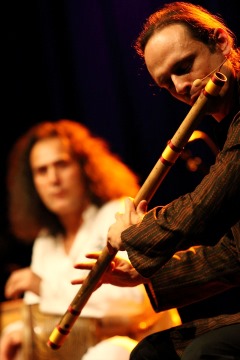 »Looking again to India, flautist Guillaume Barraud leads his quartet in 'Kalavati' named after the Indian raga of the same name.Guillaume took tutelage for many years with the legendary bansuri master Pandit Hariprasad Chaurasia.«
»Looking again to India, flautist Guillaume Barraud leads his quartet in 'Kalavati' named after the Indian raga of the same name.Guillaume took tutelage for many years with the legendary bansuri master Pandit Hariprasad Chaurasia.«
 www.guillaume
www.guillaume
barraud.com
Some musicians and curators of music have come to dislike the term "world music". To these critics, "world music" is a parochial, catch-all marketing term for non-Western music of all genres. In October 1999, Luaka Bop label founder and ex-Talking Heads frontman David Byrne wrote an "I Hate World Music" editorial in The New York Times explaining his objections to the term. Byrne argued that the labelling and categorization of other cultures as "exotic" serves to attract an insincere consumption and deter other potential consumers.
Awards
The BBC Radio 3 Awards for World Music was an award given to world music artists between 2002 and 2008, sponsored by BBC Radio 3. The award was thought up by fRoots magazine's editor Ian Anderson, inspired by the BBC Radio 2 Folk Awards. Award categories included: Africa, Asia/Pacific, Americas, Europe, Mid East and North Africa, Newcomer, Culture Crossing, Club Global, Album of the Year, and Audience Award. Initial lists of nominees in each category were selected annually by a panel of several thousand industry experts. Shortlisted nominees were voted on by a twelve-member jury, which selected the winners in every category except for the Audience Award category. These jury members were appointed and presided over by the BBC. The annual awards ceremony was held at the BBC Proms and winners were given an award called a "Planet". In March 2009, the BBC made a decision to axe the BBC Radio 3 Awards for World Music.
In response to the BBC's decision to end its awards program, the British world music magazine Songlines launched the Songlines Music Awards in 2009 "to recognise outstanding talent in world music".
 »Ramzi Aburedwan is Riverboat Records only releasing artist from Palestine. A virtuoso musician and arranger, Ramzi's 2012 album Reflections of Palestine is one of the many treasures in the label's back catalogue.«
»Ramzi Aburedwan is Riverboat Records only releasing artist from Palestine. A virtuoso musician and arranger, Ramzi's 2012 album Reflections of Palestine is one of the many treasures in the label's back catalogue.«
 www.ramzi
www.ramzi
aburedwan.com
The WOMEX Awards were introduced in 1999 to honor the high points of world music on an international level and to acknowledge musical excellence, social importance, commercial success, political impact and lifetime achievement. Every October at the WOMEX event, the award figurine—an ancient mother goddess statue dating back about 6000 years to the Neolithic age—is presented in an award ceremony to a worthy member of the world music community.
Rough Guides
Rough Guides Ltd is a British travel guidebook and reference publisher, since November 2017 owned by APA Publications. Its travel titles cover more than 200 destinations. The series began with the 1982 Rough Guide to Greece, a book conceived by Mark Ellingham, who was dissatisfied with the polarisation of existing guidebooks between cost-obsessed student guides and "heavyweight cultural tomes".
Initially, the series was aimed at low-budget backpackers. The Rough Guides books have incorporated more expensive recommendations since the early 1990s, and books have had colour printing since the late 1990s, which are now marketed to travellers on all budgets. Much of the books' travel content is also available online.
Ellingham left Rough Guides in November 2007, after the company had celebrated "25 Rough Years" with a celebratory series of books, to set up a new green and ethical imprint, GreenProfile, at Profile Books. Rough Guides was run from 2003 until later in the decade by co-founder Martin Dunford (travel) and Andrew Lockett (reference), under the aegis of Penguin before their merger with Random House.
In 2017, Rough Guides was sold to APA Publications, parent of Insight Guides. It is now based at APA's offices in Tooley Street, near London Bridge.
The slogan of Rough Guides is "Make the Most of Your Time on Earth".
Music
In association with UK-based record label World Music Network, Rough Guides has issued over 350 recorded anthologies of the music of various nations and regions. In addition to their "Rough Guide" Series, the record label World Music Network has released 130 recordings in their other "Introducing", "Riverboat", and "Think Global" Series.
Albums released in the series include The Rough Guide to... Bhangra, Tito Puente, Romanian Gypsies, Hungarian Gypsies and Ali Hassan Kuban.
From Wikipedia, the free encyclopedia
[en.wikipedia.org/wiki/World_music,
en.wikipedia.org/wiki/Rough_Guides].
Wikipedia® is a registered trademark of the Wikimedia Foundation, Inc., a non-profit organization.
Text is available under the Creative Commons Attribution-ShareAlike License.
Date: June 2018.
Photo Credits:
(1ff) Rough Guides,
(8) Kries,
(9) Monoswezi,
(10) Nordic Raga,
(11) Muzsikas,
(12) Sutari,
(13) Debashish Bhattacharya,
(14) Alba Griot,
(15) Trio Tekke ,
(16) Rafiki Jazz,
(17) Kristi Stassinopoulou & Stathis Kalyviotis,
(19) She'Koyokh,
(20) Amsterdam Klezmer Band,
(21) Klezmatics,
(22) Lucilla Galeazzi ,
(23) Krar Collective,
(23) Shanren,
(24) Söndörgő,
(25) Rocqawali,
(26) Guillaume Barraud,
(27) Ramzi Aburedwan
(unknown/website);
(18) Etran Finatawa,
(by Walkin' Tom).
FolkWorld - Home of European Music
 Layout & Idea of FolkWorld © The Mollis - Editors of FolkWorld
Layout & Idea of FolkWorld © The Mollis - Editors of FolkWorld


